Early-Holocene Episodic Sedimentary Process on the East Hainan Coast: High-Resolution Chronological Refinement, Titanium Intensity and Flux Implications
Abstract
1. Introduction
2. Study Area
3. Samples and Methods
3.1. Materials and Samples
Core NH01
3.2. Luminescence Dating
3.2.1. Sample Preparation
3.2.2. Instrumentation and Methodology
3.3. Dosimetry
3.4. X-Ray Fluorescence (XRF) Scanning
4. Results and Discussion
4.1. Revised Luminescence Chronology
4.1.1. Quartz Luminescence Characteristics and De Determination
4.1.2. Luminescence Ages and Sedimentation Rate
4.2. Titanium Intensities, Flux and Environmental Implications
4.2.1. Ti Intensity and Flux Variation During ~16.0–7.0 ka
4.2.2. Environmental Evolution on the East Hainan Coast During ~16.0–7.0 ka by the Refined OSL Chronology and Titanium Characteristics
5. Conclusions
- Both the pIR-blue OSL and conventional blue-OSL signal are applicable in this study. The feldspar contamination was almost negligible for the fine-grained quartz fraction.
- According to the refined chronology, two sedimentation stages were divided from the YD period to the early Holocene. The sedimentation rate was ca. 0.60 m/ka before 10.97 ka, while it increased abruptly (ca. 5.89 m/ka) during the period of 10.97–9.27 ka.
- During 16.00–9.27 ka, the evolution of both EASM and MWP events was driving the sedimentary process. MWP-1B triggered a surge in Ti flux at 10.5 and 9.8 ka due to the intensified monsoon-driven runoff and ITCZ-driven precipitation. In contrast, the Ti flux was not sensitive to MWP-1A due to the lack of input from terrestrial sediments. The sea-level rise (the connection of Qiongzhou Strait, ~8.5 ka) reconstructed the coastal geomorphology, diverting sediment transport pathways and isolating the study area from terrigenous inputs.
Author Contributions
Funding
Institutional Review Board Statement
Informed Consent Statement
Data Availability Statement
Acknowledgments
Conflicts of Interest
References
- Moros, M.; Andrews, J.T.; Eberl, D.D.; Jansen, E. Holocene history of drift ice in the northern North Atlantic: Evidence for different spatial and temporal modes. Paleoceanography 2006, 21. [Google Scholar] [CrossRef]
- Tan, L.; Xu, H. Editorial: Holocene Climate Changes in the Asia Pacific Region. Front. Earth Sci. 2021, 8, 622792. [Google Scholar] [CrossRef]
- Hong, Y.T.; Hong, B.; Lin, Q.A.; Shibata, Y.; Hirota, M.; Zhu, Y.X.; Leng, X.T.; Wang, T.; Yi, L. Inverse phase oscillations between the East Asian and Indian Ocean summer monsoons during the last 12,000 years and paleo-El Niño. Earth Planet. Sci. Lett. 2005, 231, 337–346. [Google Scholar] [CrossRef]
- Rasmussen, S.O.; Vinther, B.M.; Clausen, H.B.; Andersen, K.K. Early Holocene climate oscillations recorded in three Greenland ice cores. Quat. Sci. Rev. 2007, 26, 1907–1914. [Google Scholar] [CrossRef]
- Yao, S.; Ling, C.; Lu, H.; Meng, Y.; Li, C.; Yu, S.Y.; Xue, B.; Wang, G. Palynological and sedimentological evidence for early mid-Holocene hydroclimatic variability in the Ningshao Plain, East China. Palaeogeogr. Palaeoclimatol. Palaeoecol. 2024, 637, 111997. [Google Scholar] [CrossRef]
- Choi, S.J.; Merritts, D.J.; Ota, Y. Elevations and ages of marine terraces and late Quaternary rock uplift in southeastern Korea. J. Geophys. Res. Solid Earth 2008, 113. [Google Scholar] [CrossRef]
- Liu, J.; Zhang, X.; Mei, X.; Zhao, Q.; Guo, X.; Zhao, W.; Liu, J.; Saito, Y.; Wu, Z.; Li, J.; et al. The sedimentary succession of the last~ 3.50 Myr in the western South Yellow Sea: Paleoenvironmental and tectonic implications. Mar. Geol. 2018, 399, 47–65. [Google Scholar] [CrossRef]
- Yin, A.; Harrison, T.M. Geologic evolution of the Himalayan-Tibetan orogen. Annu. Rev. Earth Planet. Sci. 2000, 28, 211–280. [Google Scholar] [CrossRef]
- Liu, W.T.; Xie, X. Spacebased observations of the seasonal changes of South Asian monsoons and oceanic responses. Geophys. Res. Lett. 1999, 26, 1473–1476. [Google Scholar] [CrossRef]
- Shintani, T.; Yamamoto, M.; Chen, M.T. Paleoenvironmental changes in the northern South China Sea over the past 28,000 years: A study of TEX86-derived sea surface temperatures and terrestrial biomarkers. J. Asian Earth Sci. 2011, 40, 1221–1229. [Google Scholar] [CrossRef]
- Ge, Q.; Liu, J.P.; Xue, Z.; Chu, F. Dispersal of the Zhujiang River (Pearl River) derived sediment in the Holocene. Acta Oceanol. Sin. 2014, 33, 1–9. [Google Scholar] [CrossRef]
- Li, M.; Ouyang, T.; Tian, C.; Zhu, Z.; Peng, S.; Tang, Z.; Qiu, Z.; Zhong, H.; Peng, X. Sedimentary responses to the East Asian monsoon and sea level variations recorded in the northern South China Sea over the past 36 kyr. J. Asian Earth Sci. 2019, 171, 213–224. [Google Scholar] [CrossRef]
- Zhou, L.; Yang, Y.; Wang, Z.; Jia, J.; Mao, L.; Li, Z.; Fang, X.; Gao, S. Investigating ENSO and WPWP modulated typhoon variability in the South China Sea during the mid–late Holocene using sedimentological evidence from southeastern Hainan Island, China. Mar. Geol. 2019, 416, 105987. [Google Scholar] [CrossRef]
- Cao, L.; Liu, J.; Shi, X.; He, W.; Chen, Z. Source-to-sink processes of fluvial sediments in the northern South China Sea: Constraints from river sediments in the coastal region of South China. J. Asian Earth Sci. 2019, 185, 104020. [Google Scholar] [CrossRef]
- Zong, Y.; Huang, K.; Yu, F.; Zheng, Z.; Switzer, A.; Huang, G.; Wang, N.; Tang, M. The role of sea-level rise, monsoonal discharge and the palaeo-landscape in the early Holocene evolution of the Pearl River delta, southern China. Quat. Sci. Rev. 2012, 54, 77–88. [Google Scholar] [CrossRef]
- Bradley, S.L.; Milne, G.A.; Horton, B.P.; Zong, Y. Modelling Sea level data from China and Malay-Thailand to estimate Holocene ice-volume equivalent sea level change. Quat. Sci. Rev. 2016, 137, 54–68. [Google Scholar] [CrossRef]
- Li, Y.; Li, Y.; Chen, M.; Xue, Y.; Zhang, J.; Wang, L.; Tong, C.; Yi, L. Sediment flux variation and environmental implications in the East Hainan Coast, South China Sea during the last 20 ka—A luminescence chronological investigation. Mar. Geol. 2025, 480, 107453. [Google Scholar] [CrossRef]
- Kaufman, D.; McKay, N.; Routson, C.; Erb, M.; Davis, B.; Heiri, O.; Jaccard, S.; Tierney, J.; Datwyler, C.; Axford, Y.; et al. A global database of Holocene paleotemperature records. Sci. Data 2020, 7, 1–34. [Google Scholar] [CrossRef]
- Fuchs, M.; Owen, L.A. Luminescence dating of glacial and associated sediments: Review, recommendations and future directions. Boreas 2008, 37, 636–659. [Google Scholar] [CrossRef]
- Zhong, J.; Ling, K.; Yang, M.; Shen, Q.; Abbas, M.; Lai, Z. Radiocarbon and OSL dating on cores from the Chaoshan delta in the coastal South China Sea. Front. Mar. Sci. 2022, 9, 1030841. [Google Scholar] [CrossRef]
- Jiang, T.; Liu, X.; Yu, T.; Hu, Y. OSL dating of late Holocene coastal sediments and its implication for sea-level eustacy in Hainan Island, Southern China. Quat. Int. 2018, 468, 24–32. [Google Scholar] [CrossRef]
- Preusser, F.; Degering, D.; Fuchs, M.; Hilgers, A.; Kadereit, A.; Klasen, N.; Krbetschek, M.; Richter, D.; Spencer, J.Q. Luminescence dating: Basics, methods and applications. EG Quat. Sci. J. 2008, 57, 95–149. [Google Scholar] [CrossRef]
- Wintle, A.G.; Murray, A.S. A review of quartz optically stimulated luminescence characteristics and their relevance in single-aliquot regeneration dating protocols. Radiat. Meas. 2006, 41, 369–391. [Google Scholar] [CrossRef]
- Roberts, H.M.; Wintle, A.G. Luminescence sensitivity changes of polymineral fine grains during IRSL and [post-IR] OSL measurements. Radiat. Meas. 2003, 37, 661–671. [Google Scholar] [CrossRef]
- Wang, L.; Hu, S.; Yu, G.; Ma, M.; Wang, Q.; Zhang, Z.; Liao, M.; Gao, L.; Ye, L.; Wang, X. Magnetic characteristics of sediments from a radial sand ridge field in the South Yellow Sea, eastern China, and environmental implications during the mid-to late-Holocene. J. Asian Earth Sci. 2018, 163, 224–234. [Google Scholar] [CrossRef]
- Shilling, A.M.; Colcord, D.E.; Karty, J.; Hansen, A.; Freeman, K.H.; Njau, J.K.; Stanistreet, I.G.; Stollhofen, H.; Schich, K.D.; Toth, N.; et al. Biogeochemical evidence from OGCP Core 2A sediments for environmental changes preceding deposition of Tuff IB and climatic transitions in Upper Bed I of the Olduvai Basin. Palaeogeogr. Palaeoclimatol. Palaeoecol. 2020, 555, 109824. [Google Scholar] [CrossRef]
- Hussain, A.; Al-Ramadan, K. A core-based XRF scanning workflow for continuous measurement of mineralogical variations in clastic reservoirs. MethodsX 2022, 9, 101928. [Google Scholar] [CrossRef] [PubMed]
- Almenningen, S.; Roy, S.; Hussain, A.; Seland, J.G.; Ersland, G. Effect of mineral composition on transverse relaxation time distributions and MR imaging of tight rocks from offshore Ireland. Minerals 2020, 10, 232. [Google Scholar] [CrossRef]
- Hussain, A.; Haughton, P.D.; Shannon, P.M.; Turner, J.N.; Pierce, C.S.; Obradors-Latre, A.; Barker, S.P.; Martinsen, O.J. High-resolution X-ray fluorescence profiling of hybrid event beds: Implications for sediment gravity flow behaviour and deposit structure. Sedimentology 2020, 67, 2850–2882. [Google Scholar] [CrossRef]
- Li, T.; Li, X.; Zhang, J.; Luo, W.; Tian, C.; Zhao, L. Source identification and co-occurrence patterns of major elements in South China Sea sediments. Mar. Geol. 2020, 428, 106285. [Google Scholar] [CrossRef]
- Sun, Y.; Wu, F.; Clemens, S.C.; Oppo, D.W. Processes controlling the geochemical composition of the South China Sea sediments during the last climatic cycle. Chem. Geol. 2008, 257, 240–246. [Google Scholar] [CrossRef]
- Xie, J.; Zhao, B.; Zhan, Q.; Li, X. Review of geochemical applications for paleoenvironmental and paleoecological analyses. Shanghai Land Resour. 2015, 3, 64–70, (In Chinese with English Abstract). [Google Scholar]
- Zhang, J.; Wang, D.R.; Jennerjahn, T.; Dsikowitzky, L. Land–sea interactions at the east coast of Hainan Island, South China Sea: A synthesis. Cont. Shelf Res. 2013, 57, 132–142. [Google Scholar] [CrossRef]
- Liu, Z.; Tuo, S.; Colin, C.; Liu, J.T.; Huang, C.Y.; Selvaraj, K.; Chen, C.T.; Zhao, Y.; Siringan, F.P.; Boulay, S.; et al. Detrital fine-grained sediment contribution from Taiwan to the northern South China Sea and its relation to regional ocean circulation. Mar. Geol. 2008, 255, 149–155. [Google Scholar] [CrossRef]
- Xu, F.; Hu, B.; Dou, Y.; Liu, X.; Wan, S.; Xu, Z.; Tian, X.; Liu, Z.; Li, A. Sediment provenance and paleoenvironmental changes in the northwestern shelf mud area of the South China Sea since the mid-Holocene. Cont. Shelf Res. 2017, 144, 21–30. [Google Scholar] [CrossRef]
- Chen, Y.; Deng, B.; Chen, Y.; Wang, D.; Zhang, J. Holocene sedimentary evolution of a subaqueous delta off a typical tropical river, Hainan Island, South China. Mar. Geol. 2021, 442, 106664. [Google Scholar] [CrossRef]
- Locarnini, R.A.; Mishonov, A.V.; Baranova, O.K.; Boyer, T.P.; Zweng, M.M.; Garcia, H.E.; Reagan, J.R.; Seidov, D.; Weathers, K.W.; Paver, C.R.; et al. World Ocean Atlas 2018, Volume 1: Temperature. In NOAA Atlas NESDIS, 81; Mishonov, A., Ed.; National Centers for Environmental Information: Silver Spring, MD, USA, 2019; p. 52. [Google Scholar]
- Jing, Z.Y.; Qi, Y.Q.; Hua, Z.L.; Zhang, H. Numerical study on the summer upwelling system in the northern continental shelf of the South China Sea. Cont. Shelf Res. 2009, 29, 467–478. [Google Scholar] [CrossRef]
- Yin, J.; Huang, L.; Li, K.; Lian, S.; Li, C.; Lin, Q. Abundance distribution and seasonal variations of Calanus sinicus (Copepoda: Calanoida) in the northwest continental shelf of South China Sea. Cont. Shelf Res. 2011, 31, 1447–1456. [Google Scholar] [CrossRef]
- Li, K.Z.; Yin, J.Q.; Huang, L.M.; Lian, S.M.; Zhang, J.L.; Liu, C.G. Monsoon-forced distribution and assemblages of appendicularians in the northwestern coastal waters of South China Sea. Estuar. Coast. Shelf Sci. 2010, 89, 145–153. [Google Scholar] [CrossRef]
- Cunningham, A.C.; Wallinga, J. Selection of integration time intervals for quartz OSL decay curves. Quat. Geochronol. 2010, 5, 657–666. [Google Scholar] [CrossRef]
- Guérin, G.; Mercier, N.; Adamiec, G. Dose-rate conversion factors: Update. Anc. Tl 2011, 29, 5–8. [Google Scholar] [CrossRef]
- Mejdahl, V. Thermoluminescence dating: Beta-dose attenuation in quartz grains. Archaeometry 1979, 21, 61–72. [Google Scholar] [CrossRef]
- Rees-Jones, J. Optical dating of young sediments using fine-grain quartz. Anc. TL 1995, 13, 9–14. [Google Scholar] [CrossRef]
- Prescott, J.R.; Hutton, J.T. Cosmic ray contributions to dose rates for luminescence and ESR dating: Large depths and long-term time variations. Radiat. Meas. 1994, 23, 497–500. [Google Scholar] [CrossRef]
- Murray, R.W.; Leinen, M.; Isern, A. Biogenic flux of Al to sediment in the central equatorial Pacific Ocean: Evidence for increased productivity during glacial periods. Paleoceanography 1993, 8, 651–670. [Google Scholar] [CrossRef]
- Blaauw, M.; Christen, J.A. Flexible paleoclimate age-depth models using an autoregressive gamma process. Bayesian Anal. 2011, 6, 457–474. [Google Scholar] [CrossRef]
- Fang, K.; Cai, B.; Liu, X.; Lei, G.; Jiang, X.; Zhao, Y.; Li, H.; Seppä, H. Climate of the late Pleistocene and early Holocene in coastal South China inferred from submerged wood samples. Quat. Int. 2017, 447, 111–117. [Google Scholar] [CrossRef]
- Kong, D.; Wei, G.; Chen, M.T.; Peng, S.; Liu, Z. Northern South China Sea SST changes over the last two millennia and possible linkage with solar irradiance. Quat. Int. 2017, 459, 29–34. [Google Scholar] [CrossRef]
- Yan, T.; Yu, K.; Jiang, L.; Li, Y.; Zhao, N. Significant sea-level fluctuations in the western tropical Pacific during the mid-Holocene. Paleoceanogr. Paleoclimatol. 2024, 39, e2023PA004783. [Google Scholar] [CrossRef]
- Chen, X.; Wu, D.; Huang, X.; Lv, F.; Brenner, M.; Jin, H.; Chen, F. Vegetation response in subtropical southwest China to rapid climate change during the Younger Dryas. Earth-Sci. Rev. 2020, 201, 103080. [Google Scholar] [CrossRef]
- Lambeck, K.; Rouby, H.; Purcell, A.; Sun, Y.; Sambridge, M. Sea level and global ice volumes from the Last Glacial Maximum to the Holocene. Proc. Natl. Acad. Sci. USA 2014, 111, 15296–15303. [Google Scholar] [CrossRef]
- Zhao, H.; Wang, L.; Yuan, J. Origin and time of Qiongzhou Strait. Mar. Geol. Quat. Geol. 2007, 27, 33–40. [Google Scholar]
- Shi, M.; Chen, C.; Xu, Q.; Lin, H.; Liu, G.; Wang, H.; Wang, F.; Yan, J. The role of Qiongzhou Strait in the seasonal variation of the South China Sea circulation. J. Phys. Oceanogr. 2002, 32, 103–121. [Google Scholar] [CrossRef]
- Xiong, H.; Zong, Y.; Qian, P.; Huang, G.; Fu, S. Holocene sea-level history of the northern coast of South China Sea. Quat. Sci. Rev. 2018, 194, 12–26. [Google Scholar] [CrossRef]
- Dodson, J.; Li, J.; Lu, F.; Zhang, W.; Yan, H.; Cao, S. A late pleistocene and holocene vegetation and environmental record from Shuangchi Maar, Hainan Province, South China. Palaeogeogr. Palaeoclimatol. Palaeoecol. 2019, 523, 89–96. [Google Scholar] [CrossRef]
- Goldberg, E.D.; Arrhenius, G.O.S. Chemistry of Pacific pelagic sediments. Geochim. Cosmochim. Acta 1958, 13, 153–212. [Google Scholar] [CrossRef]
- Schroeder, J.O.; Murray, R.W.; Leinen, M.; Pflaum, R.C.; Janecek, T.R. Barium in equatorial Pacific carbonate sediment: Terrigenous, oxide, and biogenic associations. Paleoceanography 1997, 12, 125–146. [Google Scholar] [CrossRef]
- Murray, R.W.; Knowlton, C.; Leinen, M.; Mix, A.C.; Polsky, C.H. Export production and carbonate dissolution in the central equatorial Pacific Ocean over the past 1 Myr. Paleoceanography 2000, 15, 570–592. [Google Scholar] [CrossRef]
- Wei, G.; Liu, Y.; Li, X.; Shao, L.; Liang, X. Climatic impact on Al, K, Sc and Ti in marine sediments: Evidence from ODP Site 1144, South China Sea. Geochem. J. 2003, 37, 593–602. [Google Scholar] [CrossRef]
- Cheng, H.; Edwards, R.L.; Sinha, A.; Spötl, C.; Yi, L.; Chen, S.; Kelly, M.; Kathayat, G.; Wang, X.; Li, X.; et al. The Asian monsoon over the past 640,000 years and ice age terminations. Nature 2016, 534, 640–646. [Google Scholar] [CrossRef]
- Berger, A. Long-term variations of caloric insolation resulting from the Earth’s orbital elements. Quat. Res. 1978, 9, 139–167. [Google Scholar] [CrossRef]
- Yin, J.; Yang, X.; Zhou, Q.; Li, G.; Gao, H.; Liu, J. Sea surface temperature and salinity variations from the end of Last Glacial Maximum (LGM) to the Holocene in the northern South China Sea. Palaeogeogr. Palaeoclimatol. Palaeoecol. 2021, 562, 110102. [Google Scholar] [CrossRef]
- Liu, J.P.; Milliman, J.D. Reconsidering melt-water pulses 1A and 1B: Global impacts of rapid sea-level rise. J. Ocean Univ. China 2004, 3, 183–190. [Google Scholar] [CrossRef]
- Berger, A.; Loutre, M.F. Insolation values for the climate of the last 10 million years. Quat. Sci. Rev. 1991, 10, 297–317. [Google Scholar] [CrossRef]
- Haug, G.H.; Hughen, K.A.; Sigman, D.M.; Peterson, L.C.; Rohl, U. Southward migration of the intertropical convergence zone through the Holocene. Science 2001, 293, 1304–1308. [Google Scholar] [CrossRef]
- Bard, E.; Hamelin, B.; Delanghe-Sabatier, D. Deglacial meltwater pulse 1B and Younger Dryas Sea levels revisited with boreholes at Tahiti. Science 2010, 327, 1235–1237. [Google Scholar] [CrossRef] [PubMed]
- Zhou, X.; Sun, L.; Zhan, T.; Huang, W.; Zhou, X.; Hao, Q.; Wang, Y.; He, X.; Zhao, C.; Zhang, J.; et al. Time-transgressive onset of the Holocene Optimum in the East Asian monsoon region. Earth Planet. Sci. Lett. 2016, 456, 39–46. [Google Scholar] [CrossRef]
- Griffiths, M.L.; Johnson, K.R.; Pausata, F.S.; White, J.C.; Henderson, G.M.; Wood, C.T.; Yang, H.; Ersek, V.; Conrad, C.; Sekhon, N. End of Green Sahara amplified mid-to late Holocene megadroughts in mainland Southeast Asia. Nat. Commun. 2020, 11, 4204. [Google Scholar] [CrossRef] [PubMed]
- Huang, X.; Zhang, H.; Griffiths, M.L.; Zhao, B.; Pausata, F.S.; Tabor, C.; Shu, J.; Xie, S. Holocene forcing of East Asian hydroclimate recorded in a subtropical peatland from southeastern China. Clim. Dyn. 2023, 60, 981–993. [Google Scholar] [CrossRef]
- Kuehl, S.A.; Levy, B.M.; Moore, W.S.; Allison, M.A. Subaqueous delta of the Ganges-Brahmaputra River system. Mar. Geol. 1997, 144, 81–96. [Google Scholar] [CrossRef]
- Xu, G.; Bi, S.; Gugliotta, M.; Liu, J.; Liu, J.P. Dispersal mechanism of fine-grained sediment in the modern mud belt of the East China Sea. Earth-Sci. Rev. 2023, 240, 104388. [Google Scholar] [CrossRef]
- Liu, J.; Steinke, S.; Vogt, C.; Mohtadi, M.; Pol-Holz, R.; Hebbeln, D. Temporal and spatial patterns of sediment deposition in the northern South China Sea over the last 50,000 years. Palaeogeogr. Palaeoclimatol. Palaeoecol. 2017, 465, 212–224. [Google Scholar] [CrossRef]
- Chen, L.; Zhang, Y.F.; Li, T.J.; Yang, W.F.; Chen, J. Sedimentary environment and its evolution of Qiongzhou Strait and nearby seas since last ten thousand years. Earth Sci. 2014, 39, 696–704. [Google Scholar]
- Li, J.; Gao, J.; Wang, Y.; Li, Y.; Bai, F.; Cees, L. Distribution and dispersal pattern of clay minerals in surface sediments, eastern Beibu Gulf, South China Sea. Acta Oceanol. Sin. 2012, 31, 78–87. [Google Scholar] [CrossRef]
- Zhang, X.; Zhang, H.; Zhang, R.; Wang, J.; Wang, M.; Liang, Z.; He, M.; Wei, R.; Cheng, H. Spatiotemporal pattern of the East Asian monsoon hydroclimate during the 8.2 ka event inferred from a new speleothem multi-proxy record from SE China. Quat. Sci. Rev. 2025, 349, 109141. [Google Scholar] [CrossRef]
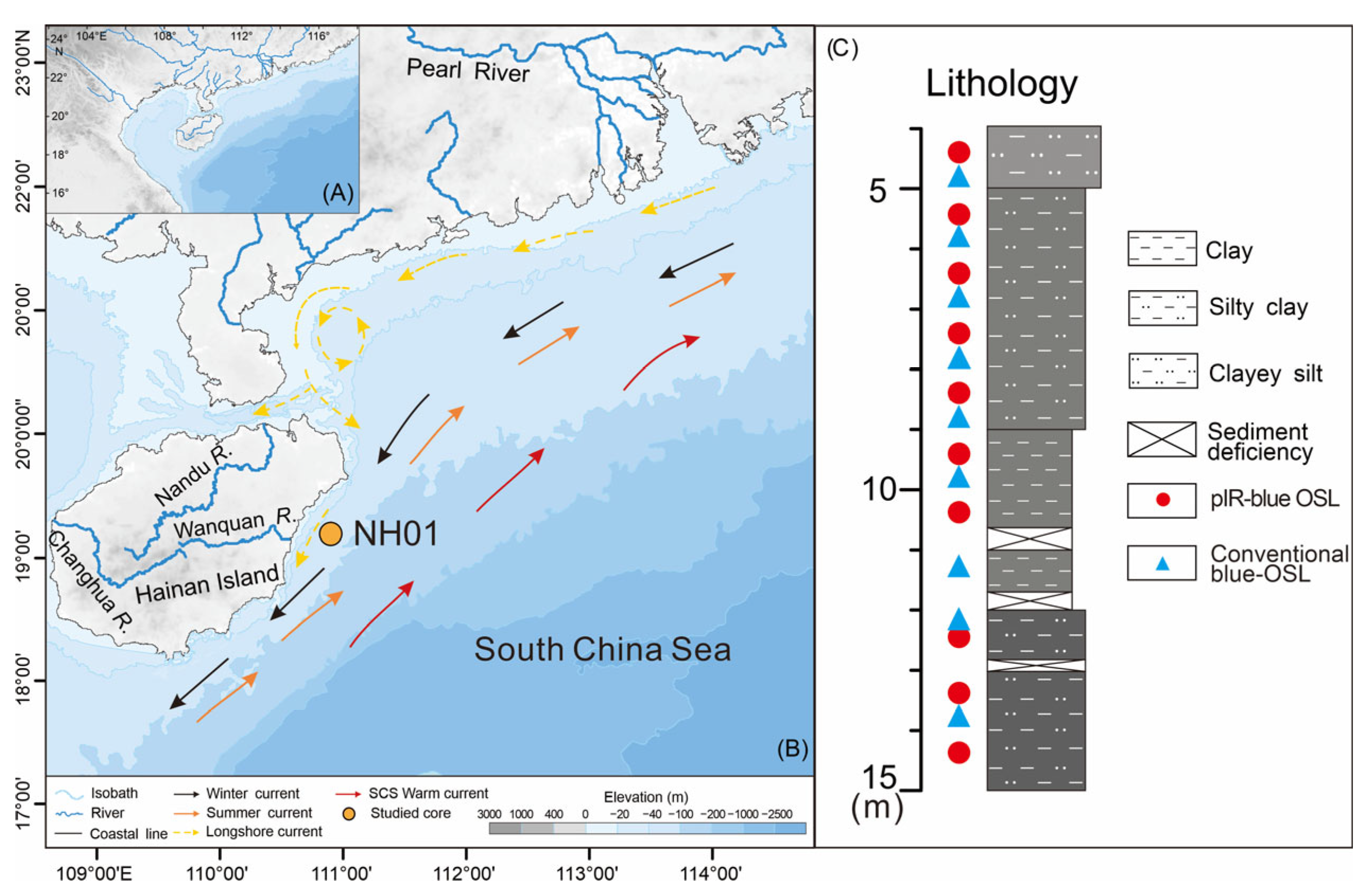
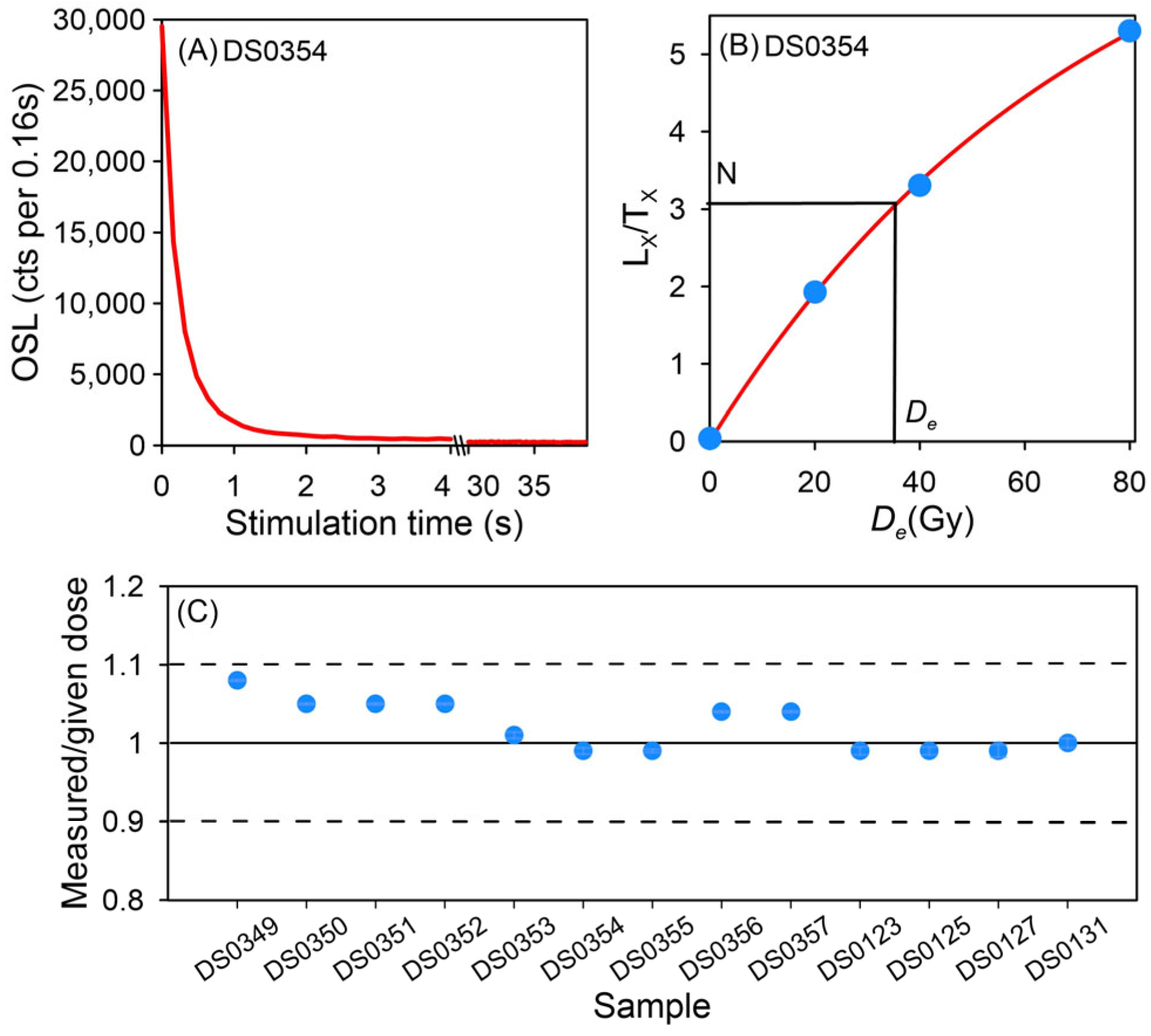
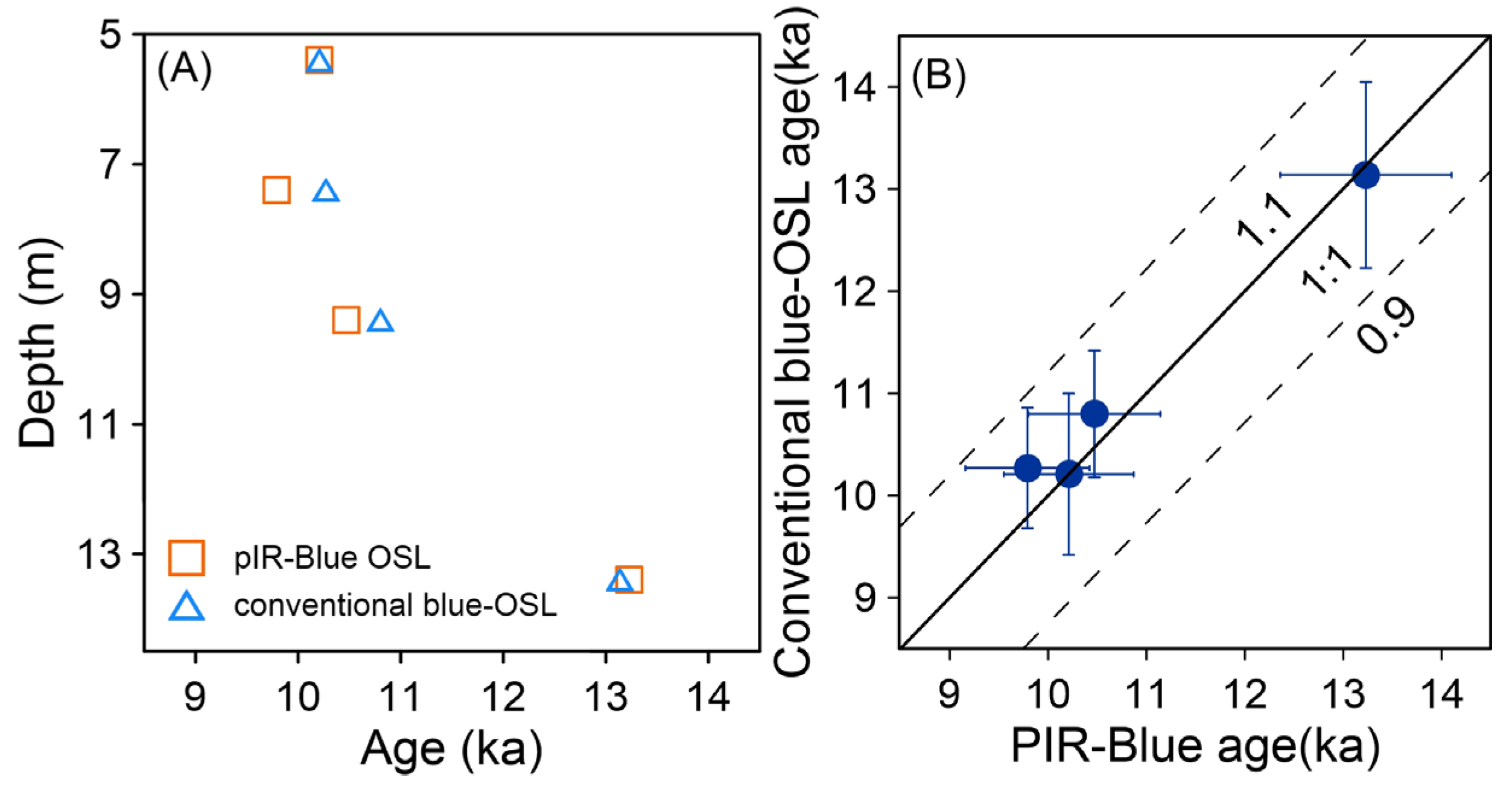
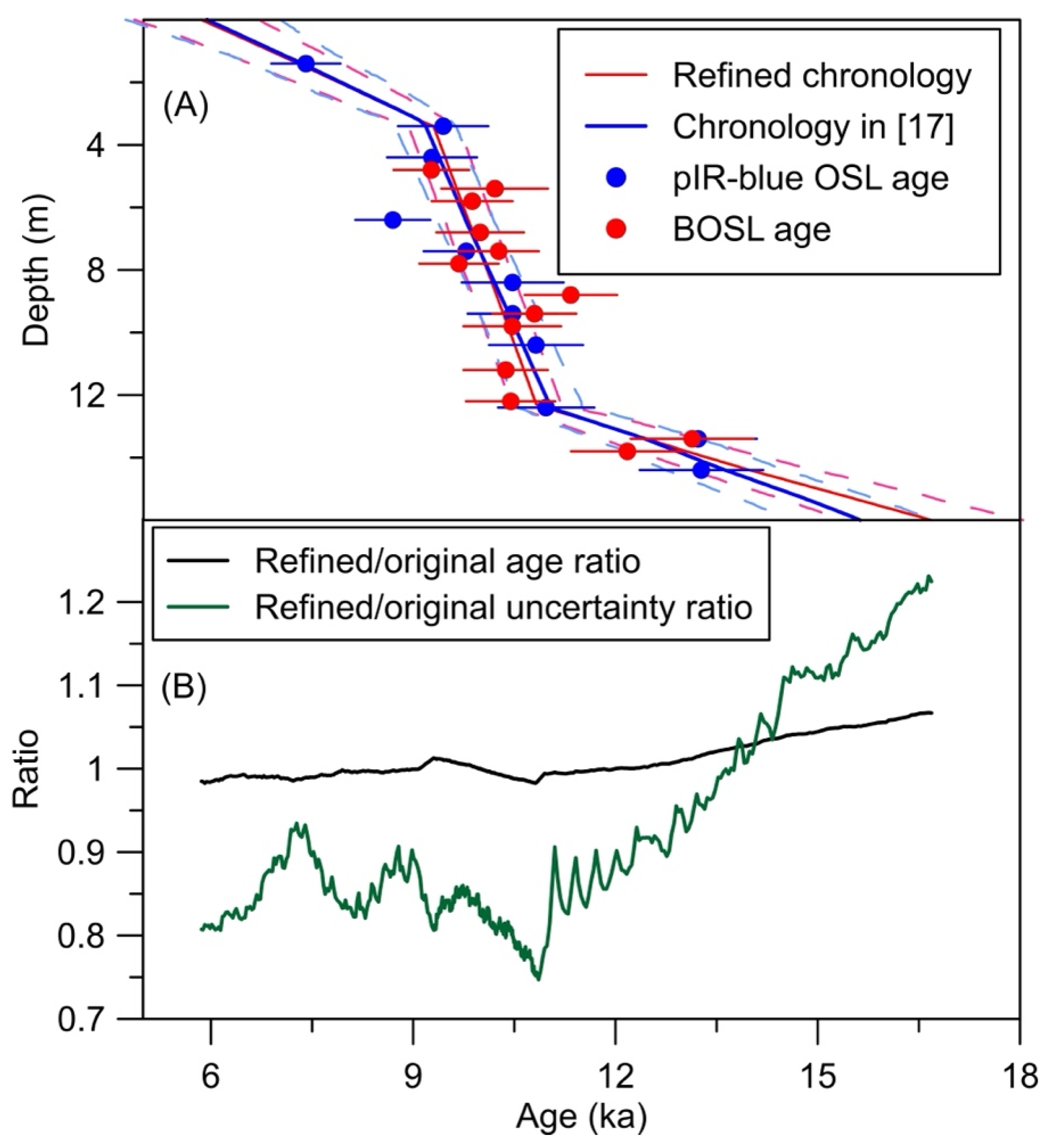
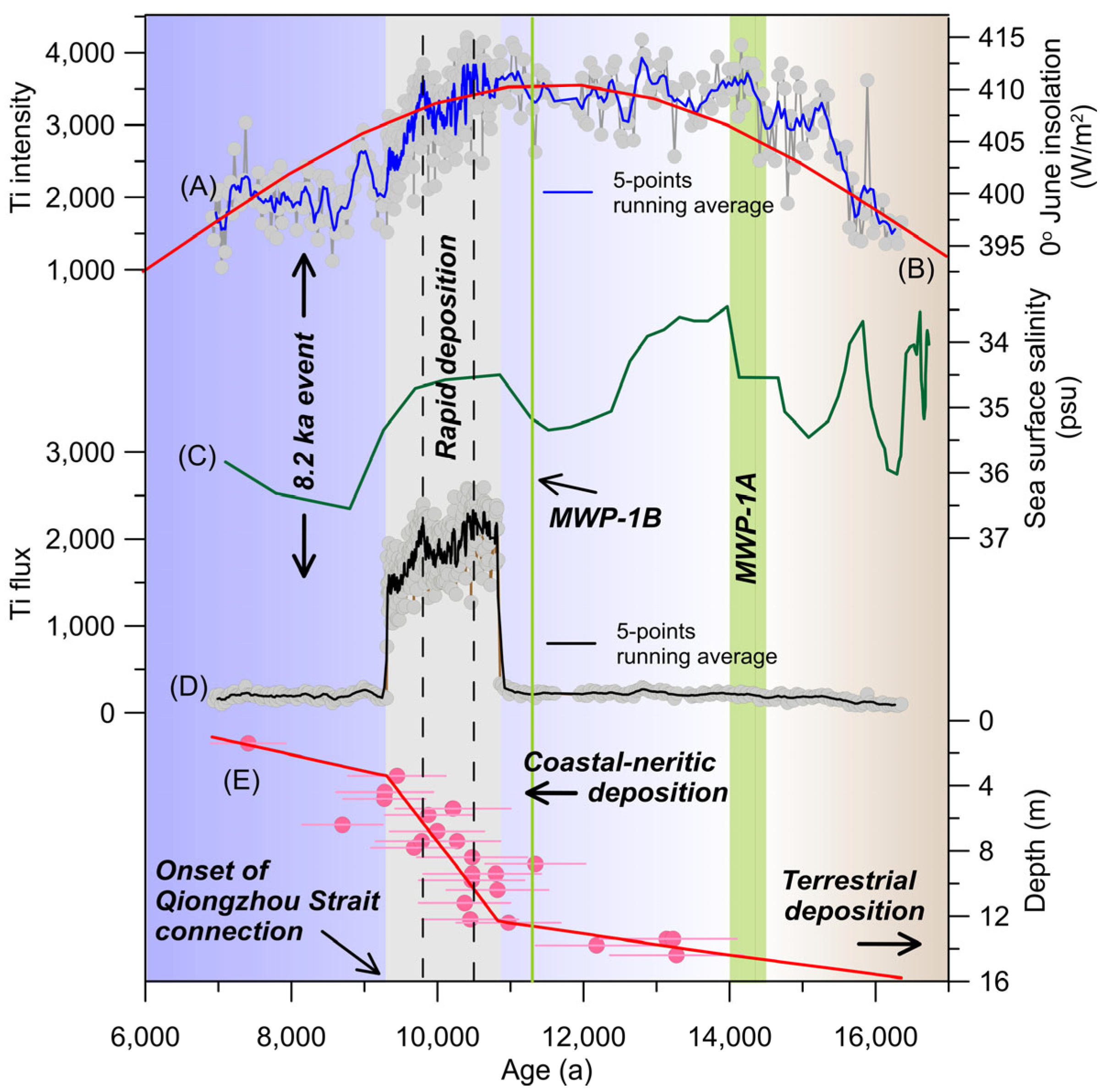
| Conventional Blue-OSL | ||
|---|---|---|
| Step | Treatment | Observed |
| 1 | N, beta dose | |
| 2 | Preheat at 200 °C for 10 s | |
| 3 | IR stimulation for 40 s 1 | |
| 4 | Blue stimulation at 125 °C for 40 s | Ln, Li |
| 5 | Beta dose (Text dose) | |
| 6 | Cutheat at 180 °C | |
| 7 | Blue stimulation at 125 °C for 40 s | Tn, Ti |
| 8 | Return to 1 | |
| Sample ID | Depth (m) | U (ppm) | Th (ppm) | K (%) | Dose Rate/Q (Gy/ka) | De (Gy) | Age (ka) | Notes |
|---|---|---|---|---|---|---|---|---|
| DS0349 | 4.8 | 2.52 ± 0.15 | 11.70 ± 1.05 | 1.76 ± 0.09 | 2.73 ± 0.16 | 25.28 ± 0.35 | 9.27 ± 0.56 | This study |
| DS0350 | 5.8 | 2.57 ± 0.15 | 12.60 ± 1.13 | 1.72 ± 0.09 | 2.76 ± 0.17 | 27.25 ± 0.18 | 9.87 ± 0.60 | |
| DS0351 | 6.8 | 2.61 ± 0.18 | 12.50 ± 1.51 | 1.68 ± 0.11 | 2.72 ± 0.18 | 27.20 ± 0.15 | 9.99 ± 0.65 | |
| DS0352 | 7.8 | 2.76 ± 0.17 | 13.00 ± 1.17 | 1.76 ± 0.09 | 2.84 ± 0.17 | 27.47 ± 0.18 | 9.68 ± 0.59 | |
| DS0353 | 8.8 | 2.41 ± 0.14 | 12.60 ± 1.13 | 1.75 ± 0.09 | 2.72 ± 0.16 | 30.88 ± 0.07 | 11.34 ± 0.69 | |
| DS0354 | 9.8 | 2.46 ± 0.15 | 14.00 ± 1.26 | 1.89 ± 0.09 | 2.93 ± 0.18 | 30.65 ± 1.05 | 10.47 ± 0.72 | |
| DS0355 | 11.2 | 2.75 ± 0.17 | 15.40 ± 1.39 | 1.99 ± 0.10 | 3.15 ± 0.19 | 32.68 ± 0.22 | 10.37 ± 0.63 | |
| DS0356 | 12.2 | 2.81 ± 0.20 | 14.80 ± 1.63 | 1.92 ± 0.11 | 3.07 ± 0.19 | 32.03 ± 0.17 | 10.45 ± 0.66 | |
| DS0357 | 13.8 | 2.46 ± 0.22 | 12.70 ± 1.76 | 1.70 ± 0.12 | 2.68 ± 0.18 | 32.64 ± 0.26 | 12.18 ± 0.83 | |
| DS0123 | 5.4 | 2.22 ± 0.13 | 12.22 ± 1.10 | 1.90 ± 0.10 | 2.79 ± 0.16 | 31.73 ± 0.93 | 10.21 ± 0.79 | |
| DS0125 | 7.4 | 2.30 ± 0.14 | 11.68 ± 1.05 | 1.87 ± 0.09 | 2.73 ± 0.16 | 31.20 ± 0.93 | 10.27 ± 0.59 | |
| DS0127 | 9.4 | 2.42 ± 0.15 | 13.04 ± 1.17 | 2.10 ± 0.11 | 3.00 ± 0.17 | 36.10 ± 1.10 | 10.80 ± 0.62 | |
| DS0131 | 13.4 | 2.17 ± 0.13 | 11.29 ± 1.02 | 1.82 ± 0.09 | 2.61 ± 0.15 | 38.12 ± 1.19 | 13.14 ± 0.91 | |
| DS0121 | 3.4 | 2.12 ± 0.13 | 9.98 ± 0.90 | 1.64 ± 0.08 | 2.09 ± 0.14 | 19.76 ± 0.41 | 9.45 ± 0.67 | Cited from [17] |
| DS0122 | 4.4 | 2.01 ± 0.12 | 11.03 ± 0.99 | 1.74 ± 0.09 | 2.18 ± 0.15 | 20.28 ± 0.46 | 9.28 ± 0.67 | |
| DS0123 | 5.4 | 2.22 ± 0.13 | 12.22 ± 1.10 | 1.90 ± 0.10 | 2.79 ± 0.16 | 28.56 ± 0.79 | 10.21 ± 0.66 | |
| DS0124 | 6.4 | 2.63 ± 0.16 | 12.96 ± 1.17 | 1.97 ± 0.10 | 2.97 ± 0.17 | 25.86 ± 0.70 | 8.70 ± 0.56 | |
| DS0125 | 7.4 | 2.30 ± 0.14 | 11.68 ± 1.05 | 1.87 ± 0.09 | 2.73 ± 0.16 | 26.75 ± 0.74 | 9.79 ± 0.63 | |
| DS0126 | 8.4 | 2.49 ± 0.15 | 12.55 ± 1.13 | 1.88 ± 0.09 | 2.39 ± 0.16 | 25.39 ± 0.59 | 10.47 ± 0.76 | |
| DS0127 | 9.4 | 2.42 ± 0.15 | 13.04 ± 1.17 | 2.10 ± 0.11 | 3.00 ± 0.17 | 31.50 ± 0.90 | 10.47 ± 0.67 | |
| DS0128 | 10.4 | 2.44 ± 0.15 | 14.08 ± 1.27 | 2.13 ± 0.11 | 3.10 ± 0.18 | 33.55 ± 0.98 | 10.82 ± 0.70 | |
| DS0130 | 12.4 | 2.61 ± 0.16 | 13.32 ± 1.20 | 2.01 ± 0.10 | 2.98 ± 0.17 | 32.75 ± 0.94 | 10.97 ± 0.71 | |
| DS0131 | 13.4 | 2.17 ± 0.13 | 11.29 ± 1.02 | 1.82 ± 0.09 | 2.61 ± 0.15 | 34.52 ± 1.00 | 13.23 ± 0.87 | |
| DS0132 | 14.4 | 2.53 ± 0.15 | 14.16 ± 1.27 | 1.77 ± 0.09 | 2.84 ± 0.18 | 37.75 ± 1.12 | 13.28 ± 0.91 |
Disclaimer/Publisher’s Note: The statements, opinions and data contained in all publications are solely those of the individual author(s) and contributor(s) and not of MDPI and/or the editor(s). MDPI and/or the editor(s) disclaim responsibility for any injury to people or property resulting from any ideas, methods, instructions or products referred to in the content. |
© 2025 by the authors. Licensee MDPI, Basel, Switzerland. This article is an open access article distributed under the terms and conditions of the Creative Commons Attribution (CC BY) license (https://creativecommons.org/licenses/by/4.0/).
Share and Cite
Chen, M.; Sun, X.; Li, Y.; Xue, Y.; Lyu, W.; Wang, X.; Li, Y. Early-Holocene Episodic Sedimentary Process on the East Hainan Coast: High-Resolution Chronological Refinement, Titanium Intensity and Flux Implications. J. Mar. Sci. Eng. 2025, 13, 527. https://doi.org/10.3390/jmse13030527
Chen M, Sun X, Li Y, Xue Y, Lyu W, Wang X, Li Y. Early-Holocene Episodic Sedimentary Process on the East Hainan Coast: High-Resolution Chronological Refinement, Titanium Intensity and Flux Implications. Journal of Marine Science and Engineering. 2025; 13(3):527. https://doi.org/10.3390/jmse13030527
Chicago/Turabian StyleChen, Mianjin, Xiao Sun, Yang Li, Yulong Xue, Wenzhe Lyu, Xuemu Wang, and Yan Li. 2025. "Early-Holocene Episodic Sedimentary Process on the East Hainan Coast: High-Resolution Chronological Refinement, Titanium Intensity and Flux Implications" Journal of Marine Science and Engineering 13, no. 3: 527. https://doi.org/10.3390/jmse13030527
APA StyleChen, M., Sun, X., Li, Y., Xue, Y., Lyu, W., Wang, X., & Li, Y. (2025). Early-Holocene Episodic Sedimentary Process on the East Hainan Coast: High-Resolution Chronological Refinement, Titanium Intensity and Flux Implications. Journal of Marine Science and Engineering, 13(3), 527. https://doi.org/10.3390/jmse13030527






